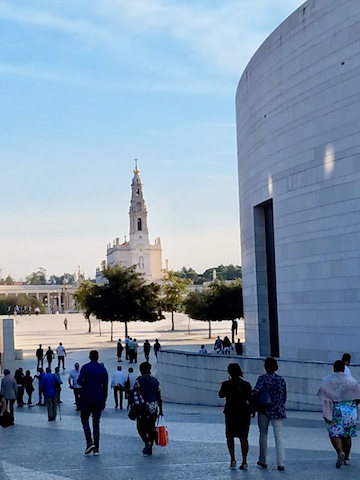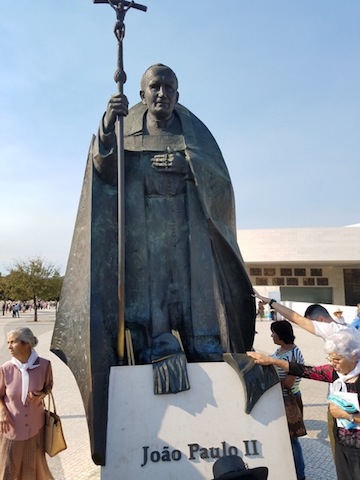The world did not tilt on its axis or end yesterday, as some devotees of an apocalyptic view of Fatima seem vaguely to have expected. The old Christian world, as the Lady warned at Fatima, however, has broadly, over the past century, shifted and fallen away. Still, the only rational response to Fatima, even if you are a faithful Catholic, is to be utterly shocked – and gripped by the strangeness of the reality: that three young peasant children, in a tiny rural village, almost unimaginably remote at the time, heard and reported remarkable things about the future of the world.
I made a point of going out of my way to spend about fourteen hours at Fatima (at my own expense) a week ago today on my way back from some professional business in Europe, because we seem to be in a period in the Church and the world when only something miraculous – and uncanny – can help us.

Skeptics, including skeptical Catholics, are often right to doubt the truth of reports of the supernatural. But not in this case. We have ample evidence – even reports from militantly secular journalists – of bizarre happenings like: the miracle of the sun (seen by 70,000 on site, and others miles away, and therefore not a “mass hallucination”). Even if you want to account for the dancing sun as some unprecedented weather event, how do you explain that the children predicted it for October 13, 1917, which is why the crowd showed up? And then there are the extraordinary visions, and sweeping prophecies, which came true, about the public world.
The skeptics have their work cut out for them to account for many things that simply cannot be dismissed by a narrow rationalism or fitted into a mild, suburban Christianity. The children at Fatima, for instance, far from perpetrating an elaborate hoax, were so unfamiliar with global events that when the Lady told them that, unless people prayed, Russia would spread her errors to the world, they didn’t even know Russia was a country. They thought it was some evil woman.
I go to Portugal fairly often to talk about political philosophy and culture – and the Portuguese also did a beautiful translation of my book The Catholic Martyrs of the Twentieth Century. But I had not been to Fatima for maybe fifteen years. It’s a very easy drive on the A1 highway now. But I was glad that my GPS mistakenly diverted me to the older E1 as I was drawing near the town – which meant that I drove through some of the still rural countryside late at night under a full harvest moon.
Because unless you appreciate how far from the things of the world that place is, even today, you will think of Fatima abstractly, as if, of course, what else is new in the history of a vast global Church? But the village of Fatima was very much on what we’re told to call today “the peripheries” – and still would be without “Fatima.”
The square of the basilica has always looked too modern to me, made even more so now by a large visitors’ center I think built to handle the centenary crowds, which weren’t large last week. They may be bigger for the actual anniversary this weekend. But even if many people aren’t physically present, to appreciate what happened you have to take a certain distance from it, realize that three peasant children not only mapped out the twentieth century’s worst features, but started world-wide devotions, the daily Rosary, Five First Saturdays, “reparations” for modern evils.

The most obvious evidence of the truth of Fatima, of course, is its connection with subsequent historical events. There was the Communist Revolution, which in line with the prophetic nature of Fatima, had not yet happened when the children reported the warning about Russia. There was the prediction of another great war (WWII) following the one then underway in 1917. And most pointedly perhaps, there was the attempted assassination of John Paul II in 1981.
One of the visions the children had was of a “man in white” being killed. JPII always believed that the Lady of Fatima had spared him: “one hand pulled the trigger, another guided the bullet.” That bullet, removed from his body after the attack, was later put into the crown of the statue of Our Lady of Fatima. Portuguese Catholics have told me they are proud of the fact that the workmen found that the bullet – what are the odds? – fit perfectly.
Protestants – to say nothing of non-Christians – find Marian devotions among the strangest things about Catholicism. And they are strange – in the same sense that the Annunciation, Incarnation, and Birth of the Savior were also strange. It’s strange that God went to a woman in an obscure Palestinian town on the peripheries of the Roman Empire to ask if she’d be willing to become what no other human being in history had been: the channel through which God Himself would come physically, as a man, into the world He had created.
Unless we too recognize and value that unanticipated strangeness, do we really appreciate the concrete reality of Christianity?
In the very last Canto of the Divine Comedy, St. Bernard of Clairvaux addresses a prayer to the Virgin asking for Dante to be granted the Beatific Vision – and that the vision won’t destroy his human affections. Among many remarkable things in the prayer, there’s this:
Lady, so great you are, such strength you bring
who does not run to you and look for grace
his wish would seek to fly without a wing.
(Esolen, Par. XXXIII, 13-15)
Does anyone believe that today? Do Catholics? Fatima offers remarkable evidence that we should. It’s a Catholic thing.














